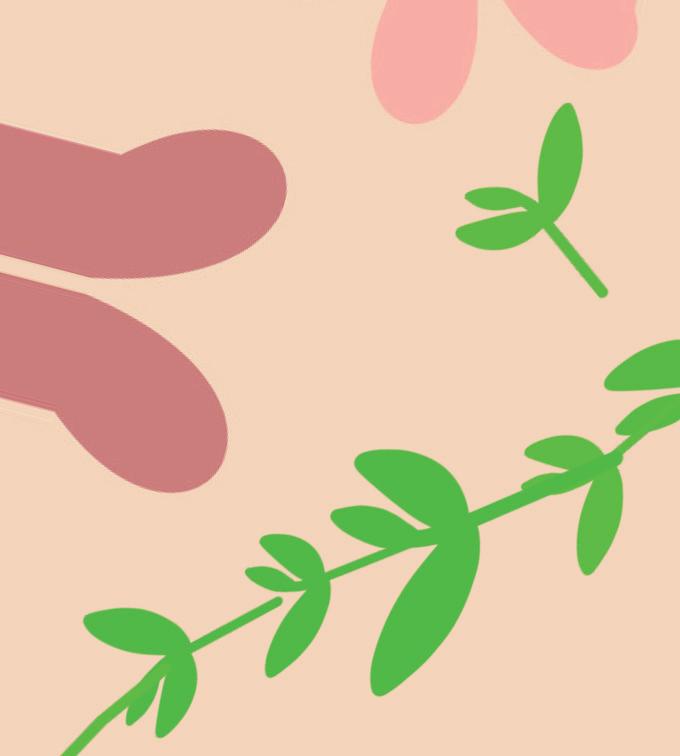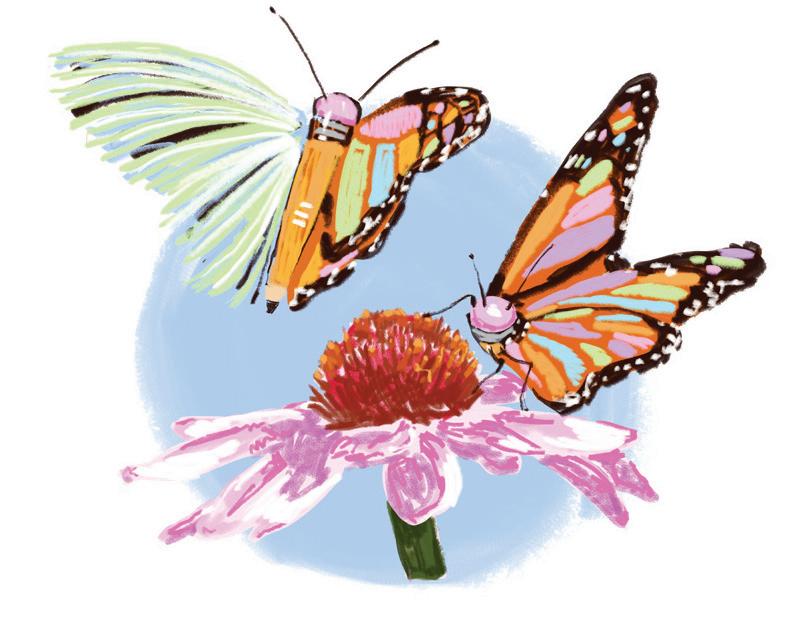


















Queer Afro-Latina artist uses music to support her mental health
BY MONICA ESQUIVELVenusia “Venus” Luisa Ortiz is an independent music artist who incorporates her Queer identity into her work, creating a voice and history for Trans women and people of color through music.
Venus is no stranger to the sound booth and rapping on a beat, she started creating music in undergrad with the encouragement of a close friend, who asked her to rap on one of his songs. She developed a passion for creating music, teaching herself how to produce and record; now releasing music under her artist name, “Queen Green.”
For Venus, music means much more than simply producing a great beat and writing a sick bar; she utilizes this creative outlet as a form of therapy.

“I think music is so healing because it allows you to express your deepest innermost thoughts, feelings and fears,” Venus said, “For me, music has been a very important tool for expressing how I feel about my identity as a Black Trans woman.”
Venus shares that she’s encountered transphobia and resistance to her identity as a Trans woman within her family, along with the rest of the world. As a form of resistance, Venus utilizes music to unapologetically express herself and forge a history as a Queer artist since most of Queer history is often overlooked, and erased.
“Music is important in terms of being therapeutic because it grants me a lineage. It grants me a history. It grants me all of these things that society and even my family is constantly denying me as a Trans woman,” Venus said.
In the rap music scene, Venus encountered situations where other male rap artists were “deeply uncomfortable with her presence.” Not only are they uncomfortable with her presence, but also her bold lyricism which contains explicit but al h








Especially when you’re Queer or Trans, people try so hard to shame us for being sexual beings in the same ways that they are [straight, cis people],” Venus said.
Venus always dressed feminine before transitioning; dressed in crop tops and sheer clothing but only dressed masculine because she felt pressured by those around her. She felt misunderstood by her family and her identity was often not taken seriously as a Queer person, ideals.
“I always felt like me just being who I was was always a challenge to everything everyone believed in,” Venus said.
Venus remembers easily coming out to her mom as gay at the age of 12 before her transition, however, coming out as trans was not an easy process. She deeply feared being rejected by her family and feared the possibility of her mom kicking her out, she took months after taking hormones to come out to her family as a transwoman.
out to others, some Transgender people endure mental turmoil to discover their transness and themselves, before even coming out to others.
Venus took two years to come to terms with her transness and often experimented with her gender presentation to better understand who she was. She admits discovering her transness was a “hard pill to swallow,” because she was overcoming internalized transphobia.
“I had a moment of soul searching that I really needed to do because I felt like I didn’t fully accept myself,” Venus said, “I was internalizing so much of what my mom and the people in my family thought it meant to be a boy and all these things.”
Anxiety rates among LGBTQ+ youth have risen since 2020 at 68%, growing from 72% in 2021 to 73% in 2022, according to the Trevor Project.
used to isolate herself and avoid certain situations because she feared not “passing” as a woman, putting herself in danger. Now that she is further into her transition, those fears and insecurities are still present, however, they appear in other ways so she continues to learn ways to embrace and love herself.
“I think people when it comes to Trans women, they want us to be ashamed of who we are. Ashamed of the transness,” Venus said, “I really try my hardest not to be but it still comes voice and I feel a little around my presentation too.”
studies at USC and moved thousands of miles away from her family to pursue higher
Another study by the American Psychiatric Association found that Queer people are 2.5 times as likely to experience anxiety, depression and substance misuse compared with their straight counterparts.
Many members of the Transgender community experience anxiety in their day-to-day lives in fear of facing violence and judgment, especially early in their transition when they do not “pass” into what society considers a man or a woman to look like.



Venus shares that earlier in her transition she









education, forced to build new friendships and navigate living in a new city on her own.
After moving to Los Angeles, Venus searched for community with people who share similar backgrounds and experiences. A USC genderstudents.
BLaQ Tea aims to support students at the intersection of both Black and Queer communities, openly discussing intersections of race, gender, sex, sexuality and various marginalized identities. They tackle issues affecting their mental health from hostile political climates and daily stressors, according to the USC Student Health website.


Venus shares that she has found a safe space and community at BLaQ Tea, creating new to improve her mental health.


“I feel like it’s so important to have a space because living at the intersection of Blackness and Queerness is such a unique sort of marginalized experience that is really challenging,” Venus said.
Ashley Stevens, a third-year dance major at the USC Glorya Kaufman School of Dance, also participates in BLaQTea and explains the importance of having therapy groups aimed toward Black and Queer students.
“The discussions we have feel very honest and very transparent about our issaues, and how they can intersect at different sectors,” Stevens said, “It feels like a team effort of bonding and also support, which is just necessary at this time frame of adulthood.”
With identity at the intersection of multiple essential to feeling understood, receiving support and attaining appropriate advice tailored to your unique experience.

“Queer and Trans people of color don’t get the support that they need to be the people that they’re gonna grow up to be in the world,” Venus said, “There’s no template for us. There is no life path that’s charted for us already, we’re constantly creating it.”
ace ew ace ess of ally the lso the med and hey aid, lso me ple ort our the hat nus life ntly ves eat; e of
For Venus, her life path in recent events involves a Trans woman, engineering the perfect rap beat; creating a history for Queer and Trans people of color everywhere.



For decades Latinas experience suicidal ideation at disproportionate rates.
BY KATIE CONTRERAS HERNANDEZLatinas fall victim to suicidal ideation
have to do with putting their needs after those of everyone else in the family. This happens especially due to the fact that young Latinas are learning to straddle two different sets of gender roles, those of their family’s country of origin and those of the United States. When trying to of who you should be, it takes a toll.
when Puerto Rican women in the Bronx were reported as having uncharacteristically high rates of suicide attempts in a study done by Dr. Edward Trautman.
In the six decades since, strides towards better Latina mental health have stayed stagnant, with a lack of conversation surrounding the issue and a steady shortage of resources through all stages of life.
In recent years steps towards talking about poor severe impact the COVID-19 pandemic has had. The internet helped facilitate this by spreading awareness through campaigns like talking about their struggles with mental health. However, these conversations have so often centered on or around white people.
The vast majority of Americans are unaware that Latinas are suffering because of the stereotype that Latine families are united. On Oct. 15th, 2018 two articles were released, one written by Charlotte Huff, a white woman, and the other by Ludmila Leiva, a Latina. Huff cites strong family bonds as being part of preventing poor mental health in Latine families, while Leiva interviews various Latinas and examines how family structure can actively harm Latina mental health. It displays the lack of cultural competence by Americans when it comes to these issues.
The data, however, paints a clearer picture. According to data from the CDC’s Youth Risk

Behavior Surveillance System (YRBSS), in 2021, 22% of high school students polled seriously considered attempting suicide and 10% did attempt to commit suicide. In that same year 4,907 Latina women died. Though the YRBSS report does not break down ethnicity by sex, across the board more women considered and attempted suicide over the past decade.
However, this is not an issue beginning in high school but is seen more in middle school. Just half an hour away from the University of Southern California, El Sereno Middle School
experiencing feelings of isolation, many didn’t know how to socialize after COVID-19, according to Jesse Barahona, site manager at Keep Youth Doing Something (KYDS) program, adding that almost four years after, suicidal ideation is still a risk.
“It started after Covid…when we came back for school for in-person learning after being in Zoom for 7 months,” Barahona said.“We saw initial reports where 6-7th graders, females, were talking about suicide and bringing
suicide in their conversations.” Adding that he reported seeing an upward trend of suicidal Latinas.
There are also resources available for girls, “At the school we have three counselors that are available during school hours and then we have a hotline which we give out to the students,” said Barahona.
KYDS also helps form safety plans for those at risk of suicide. However, once they go home, Barahona admits that they have no resources and the numbers of those who are suicidal are still high. In the last two years, Barahona estimates that 20 to 30 girls, mostly in the 7th grade have approached someone on staff about being suicidal or considering suicide.
Generally for Latinas, this largely has to do with “familialism,” a concept where the individual puts aside their needs for the greater good of the family unit. As a consequence of the
stigmatization surrounding mental health in the Latine community, when Latinas are struggling they often don’t bring it up to their family because it seems like a small problem compared to other issues. Issues like living in poverty, managing a language barrier or living in the United States as
to translate the feelings they’re experiencing into something that seems worth mentioning to their caregivers. Familialism can be a positive factor to the situation if the individual’s poor mental health is prioritized, but this often doesn’t happen.
These ideas have been explored by researchers writing academic papers, with testimonies from young Latinas pointing towards the same direction: they are being failed. In a study conducted by a professor at The University of Texas, Austin, Margarita, a 17-year-old Latina spoke on why she self-harms. “It’s like I have so much pain inside, it’s kinda like I cry inside. It’s kind of hard to explain. But like, I guess when I cut myself, I feel like I’m letting out endless words. I’m taking out my pain.”

like I was under anesthesia like they had put something in me. I felt like nothing hurt me. My mind was blank.]”
“Staffed by fellow Latinas …higher education”
These testimonies are powerful but still point to a lack of resources even for those taking them in. The language in these academic papers renders them inaccessible to anyone who hasn’t had access to higher education. When young Latinas are at risk of committing suicide, they’re not looking for academic journals, they’re looking for resources.
In the same study, a 13-year-old who remained unnamed, described feeling numb, “Parecía como si estuviera bajo anestesia, como si me hubieran puesto algo. Sventía como si no me doliera nada. Mi mente estaba en blanco. [It was
These young Latinas go on to become collegeaged Latinas, still struggling with mental health as they didn’t have access to organizations in middle or high school. At USC, located in a city with one of the most concentrated populations of Latines and a high rate of enrollment for Latines, Latina suicide is seldom talked about.
The resources available for being Latina in

generation mentors, however, there is an towards Latina mental health.
Though La CASA has an embedded counselor, there has been no recognition of this issue by the university. Showing presentations on Latina mental health, offering resources geared
starting a mentoring program with the USC magnet schools to begin prevention early on would aid greatly in this issue.
Prevention programs for Latinas are virtually non-existent in colleges, with only one of its kind existing in middle schools in New York. The Life Is Precious (LIP) organization is an Latinas aged 12-17. The program has existed for 15 years and has helped around 300 Latinas. Not a single person who’s entered the program has died from suicide.
Organizations like LIP have proven that when hugely from them.
Unfortunately, LIP is one of the only programs of its kind. No other program geared towards Latinas exists across the US and the cost of therapy is simply unrealistic for many. On average, out-of-pocket family therapy in Los Angeles is at least $300. In 2022, 27.6 million people were uninsured nationwide according to the CDC, making that out-of-pocket cost impossible . Even with insurance and if the cost were lowered to $20 a session out of pocket, that’s still $80 less a month for something that likely isn’t at the top of the priority list for a struggling family. For the 10 million Latines living under the poverty line according to the latest census, that $80 dollars are simply indispensable.
The answer to prevention comes back to our schools, especially our higher education schools who have made continued promises to aid the communities within the student body. While some schools like SMU and LMU have centers focused on Latine mental health, neither of them focuses on Latinas in particular. Universities have to be willing to put in the work to learn about why Latinas are struggling to create genuinely impactful programs.


















The scariest part talking about mental health in my Mexican household was taking the first jump.BY MYRIAM-FERNANDA ALCALA DELGADO
“Cómo estás Mija?”
“Bien.”
What I actually meant: my concentration has gone to shit, I feel like punching a wall and there’s no way to differentiate what’s real anymore. At the time, I didn’t know my medication was inducing the worst manic version of myself — I felt great. So, in a way, “bien” wasn’t a complete lie.
In my Mexican household, the “work-hard” mentality dominated. I would watch my parents work in the day, and every night, they would volunteer at church. Rest wasn’t in their cultural vocabulary; inadvertently, this was an inherited mindset: Brown bodies and brains are destined to keep going.
When I would take a breath, it was a challenge to feel valid in my emotions. Discontent, dread and depression were vocalized struggles that would often be met with “pray more” and keep going.
One day, I was forced to stop.
On a raveled, monitored landline in the furthest corner of the hospital, I dialed my mom’s number. Across state lines, we opened a line of communication about mental health.
For my Mexican parents, depression wasn’t an easy topic to understand, let alone Bipolar 1. On my 20th birthday over breakfast they began to ask questions: when did you start feeling like this? What is mania? How can we help?
This grew into a chapter of collective unlearning. We had to learn to stop blaming each

other and truly listen. The invisible barriers which barred honest communication between loved ones slowly began to look like a small log we needed to jump across together.
As younger Latines want to address mental health, there is an ever present fear of traditional perspectives from older gener-
our cultural struggles to accept concepts of depression or anxiety; embedded in my own mind was a misunderstanding of Bipolar.

You hear about a change in weather being labeled “bipolar” by supposed friends; on TikTok it’s now quirky to pretend to have BPD or BD; for former friends and partners, one google search about the condition was enough of an excuse to run for the hills.
When the world tells you to be scared of yourself, how could you not be?
After my initial diagnosis, the next three years became a whirlwind of changing medication and doses, withdrawal, substance n
abuse, sobriety, starting then stopping psychiatric visits; and, countless attempts at denying my diagnosis.
To live with a mood disorder takes skill. You expertise in Bipolar — mine showed me my brian chemistry contributed to my creativity as it did for my literary idols like Emily Dickinson. You have to stop bullshitting yourself — when I refused medication for half a year, it also took so much energy shifting drastically from depression to euphoria while staying up to date with school work and social relationships.
There was also the need to stop, this was a weird feeling. For years, acknowledging my own experience did not feel like an option, until I realized pausing was crucial to survival.
Kindness became crucial to acceptance. Still, my mental health journey is not a straight path, it won’t ever be. There are milestones along the way which have guided me though:
people in was the hardest part. There is a fear of being a burden, not being strong enough. But, I’ve learned my parents and true loved ones will never see me as a hassle. Despite cultural stigmas, opening up has allowed me to see how powerful relationships can be in healing.
I let my mom see my lowest points and help me keep up with basic needs over summer. When my sister asks what’s wrong, I am honest about the anxiety attack I just had. My girlfriend has shown me she is willing to be patient and I allow myself to be taken to the beach or sit in the grass when I need it. And, even with my support system, I know when to call my therapist and ask for professional guidance.
Medication won’t solve everything and autonomy over my regime was the key. For a while I didn’t advocate for my medical needs, I simply took what was given. I have been on at least ten different treatment plans

lower my depressive episodes but trigger mania. I also adopted the unhealthy habit of stopping medication whenever I felt “better” then would hit a new high/low and go back on.
Finding a psychiatrist who listens to my needs was as important as learning how to stand up for myself. Now I feel like my life isn’t completely consumed by my mood. I still have depressive and manic symptoms; however, they’re not debilitating.
Progress and regression are false narratives, I’m doing better even if it doesn’t feel like it. My journey will never be linear.
Coming down from mania, I would resent that I didn’t catch the signs; during depression, frustration clouded my judgment. But overtime, acceptance has become crucial to not feeling regression. I’ve accepted my diagnosis. There is no getting better, no getting worse, there is simply the choice to keep going; and, not in the mechanical way but by giving myself grace.
Patience, love and kindness. It was up to me to start a conversation about mental health in my Mexican household, but, it was also up to me to start that conversation with myself. I can’t be a sibling, friend or girlfriend if I can’t show up for myself.
Now when my mom asks, “Mija, cómo estás?”
I answer honestly, “Esto es lo que siento…”






Editor’s Note: Interviewees are anonymous to keep citizenship status private.BY ALEXA HERNANDEZ DIAZ
In the shadows of university life, four undocumented California students bravely unveil their battles with depression, anxiety, and thoughts of despair. Their stories echo a desperate cry for practical solutions and a glimmer of hope amid the tumultuous journey they face.
“This is affecting my mental health in the worst way possible. I would not recommend it to anybody. We migrate to different countries for a But I don’t think it’s worth your mental health. I think it is worth the trauma,” said Student D with tears rolling down her face recounting the decades
This is not just one person’s story, it is the individuals who share this painful cost in the pursuit of a better future.
The Presidents’ Alliance on Higher Education and American Immigration estimates that 408,000 undocumented students are enrolled in postsecondary education. In California, Gov. Gavin Newsom signed a law in 2019 requiring all public colleges and universities to have a designated dream resource liaison for each of their campuses; private universities are not required meaning undocumented students in these environments are left to navigate the journey alone.

Obama’s DACA program, chose to move from Indiana to California for university and its perceived opportunities for undocumented students.
Student B moved to the U.S. from the Philippines at the young age of six months old. She lived in the U.S. as a dependent immigrant until the COVID-19 pandemic’s legal processing halt left her without status. While the United States has been her only home, the feeling of isolation is heightened at a large institution that fails to provide proper resources for undocumented migrant students.
Student C, born in Mexico moved to the United States at four. Their life has been cast with a daunting burden of secrecy and the fear of deportation from disclosure. The revelation of her undocumented status to a dismissive professor resulted in a mental health crisis.
“The Dream center on campus is wonderful…there’s al lot of things that we know and we help students out”
Student D, originally from Nigeria, arrived in the United States at the age of 9. She

navigating opportunities she never imagined would be possible due to her status such as getting a university education, she explains, “Every time I thought about a goal I wanted to achieve, I would always revert to the conversation I had with the lawyer- ‘she can get a driver’s license, she can’t get a job, she doesn’t have an ID so she can’t do this, she can’t travel, she can’t apply for a passport.” Despite recent work authorization, she emphasizes the ongoing struggle for validation in this country.
In September 2020, studies by Delaware State University revealed a harsh reality- that dreamers are twice as likely to have depression. Reasoning? Academic stress, immigration concerns, the pandemic and job barriers. A subsequent 2021
unveiling increased instances of depression, fear of haunting the undocumented student community.
Student B shares the struggle of feeling isolated and misunderstood at her university, The University of Southern California, a large institution that lacks
proper resources for undocumented students. Advocating for oneself amidst legal limitations challenges. “Being the only person advocating for yourself, that’s the scariest thing,” she admits. She notes that invisible isolation is
conveying legal limitations to Americans, she says, “You know you can do everything your counterpart can do [internships and jobs], but you can’t because of legal limitations.” Disclosing undocumented status becomes a delicate task, with fears of xenophobia and unknown allies.
A conversation with a dismissive USC faculty member deepened her isolation, leaving her feeling unheard in a place that ostensibly promotes diversity and equity “Yes, that’s a problem, but it’s just not a big enough problem,” she recalls.
For Student C, diagnosis of anxiety, depression and potential OCD are prominent in her academic journey. Expulsion from a club, they believe, was based on their undocumented status by a USC professor that triggered emotional distress, leading to a leave of absence. Disclosing mental health struggles, they reveal, “I know it got to a point where I thought about suicide. And then I thought it couldn’t be my own because it could affect the status of my family.”
The pursuit of education becomes a battle between the importance of a degree and the looming feelings of isolation within the unpredictable political climate. Student C explains, “Everything else politically is up in the air and at least at the end of the day, you have your degree, or you have your master’s, and if something ever works out, you have those tools already. But it’s very hard, at least personally, if you don’t know if you’re going to be here tomorrow.”
Student D shares a survival mindset ingrained from childhood, where every achievement served as a shield against deportation threats: Academic validation. Academic validation became a lifeline, leading to a fear of losing things and struggling to enjoy life. She explains, “I had a fear of losing things because I didn’t think I deserved it. And I’ve seen this pattern go into relationships, go into friendships, even go into careers. I’m so used to doing my own thing that if somebody is helping me, I will think that they’re helping me with bad intent because that’s what I grew up with. I grew up with this survival mindset.” This mindset made her rank 3 out of 351 students in her senior class, but it left
learning to live beyond the need to prove her worth through academic success, saying, “There’s still a lot that I’m trying to unlearn with my mental health. Like learning how to enjoy myself. I never once enjoyed myself during all the extracurriculars I did.
I’ve never sat down. I couldn’t tell you when I have been happy.”
Student C describes counseling sessions that fail to fully address their unique challenges, deepening their feelings of being seen as cases rather than individuals. Student C explains, “I doesn’t feel like you’re fully you’re talking to someone who can fully see you.”
Kevyn underscored the critical necessity for USC, a private university, to pioneer a Dream Research Center, drawing inspiration from the trailblazing initiative efforts of Loyola Marymount University,
center. Kevyn emphasizes, “There are just so many struggles and complexities that come with our status, and we need someone to guide us because we’re just all lost at the end of the day.”
Student D, actively engaged in the policy education and advocacy department for Undocumented Student Support Services at LMU, praises LMU’s Dream Center. This emphasizes the importance of not only direct resources but also visibility for undocumented students in private institutions.
On Sept. 13, 2023, the U.S. District Court for the
the DACA Final Rule unlawful and questions arise on how universities handle new generations of undocumented students. This collective plea calls for USC and other private schools to take proactive steps, establish a dedicated Dream Research Center, and provide essential resources for the undocumented community.
Student D, an advocate for LMU’s Undocumented Student Support Services, declares, “Being undocumented should be normalized. A lot of people are undocumented. You just don’t know because there’s a negative connotation to it,” championing the call for inclusivity, understanding, and tangible support for undocumented students within private colleges across California and nationwide.




Under the dimly lit, early evening sky of Los Angeles, the neighborhood of Boyle Heights is ending this November Monday on a busy note. Up and down Cesar Chavez Avenue, members of the predominantly Latino community
restaurants, salons and stores to grab dinner, make their last purchases or close their businesses for the day. The road itself is nearly at a standstill in both lanes around 5:30 p.m.
But inside the address of 2119 Cesar Chavez Ave. is a different type of scene. Walking past the black gate front door into the brick building, painted white on the outside with a yellow sign that says “QVO Laboratories” above the words “clothes,” “movies,”
b—----” written in Spanish, there is a quiet hum within.

discuss issues of housing in the city. It is a time not only for participants to talk about the challenges and anxieties they face, but also for CPC organizers to empower the group by educating them about their rights as residents.
These meetings began in 2020 during COVID-19 pandemic when many workers within this community lost their jobs and struggled to pay rent. Yet, the gatherings have continued as issues
“As Latinos and as renters, they assume they have power over us,”
“They’re in the back,” a man says, signaling to pass through the front room —containing clothes, record players and bins of knick-knacks— toward the back of the building.
As the hum grows louder, so does the smell of tortillas and coffee. The hum turns into light chatter, as you suddenly stand outside of a
ages. The walls hung with various T-shirts and sweatshirts, the crowd moves back and forth between their seats and the El Pollo Loco at the back of the room. Then someone announces that the meeting is about to begin.
Motioning for people to take their seats, the man, wearing a shirt that says “Colectivo Poder Comunitario,” says they’ll start with their acuerdos comunitarios (community agreements.)
Every other Monday, organizers from Colectivo Poder Comunitario/Community Power Collective (CPC) —an organization that advocates for low-income tenants and vendors in Boyle Heights and East LA— and community members come together to

increases and eviction persist in this historic neighborhood.
As the group of about 40 people settle into their seats, they pass around a register where they add their contact information for future meetings. CPC team member Roberto Garcia-Ceballos then proceeds to read from the acuerdos, which include mente abierta/open mind, llegar a tiempo/be on time, mantengas el respeto/be respectful and solo un micrófono, which is their way of asking people to speak one at a time.
inviting them to share their problems, wins or questions. People glance around nervously before one older man volunteers.
Wearing a baseball cap, a basketball jersey and shorts, he introduces himself and his wife, who sits beside him with her ankles crossed and her purse in her lap.
He shares that they recently received a notice at theirapartmenttellingthem to take down their security cameras for the privacy of their neighbor.

He asks the group why this would happen —why would a landlord want to create a rift between their tenants?
“Porque dueños ganan cuando vecinos pelean answers.
Garcia-Ceballos uses this moment to explain the importance of forming relationships with neighbors and being united with them as tenants. Building a community of solidarity, he says, is the greatest power that renters have when facing housing issues.
The next person to speak is a man who brought his wife and young daughter. His landlord just told him to vacate their unit so that the landlord’s relative from Argentina can come live in it.
The man and his wife have lived in this duplex unit for 18 years, he says, and they were even there before the new landlord bought the property.
“They knew we were renting when they bought the place,” he said.
Another wave of voices erupt and Eva Garcia, another CPC team member, quiets the group.
She says if all they’ve received is a verbal cannot legally evict them. This is only a scare tactic that landlords often use to intimidate their residents.
“They are assuming you don’t know your rights,” Garcia says. She elaborates that tenants should take advantage of this assumption and deploy their legal knowledge against landlords when they think they’ve won the battle.
“As Latinos and as renters, they assume they
have power over us,” Garcia-Ceballos adds.
CPC worker Margarita Gonzalez then covers some basic tips for renters. These include using cellphones to record evidence when landlords do things they are not supposed to, like entering a unit without giving at least a 24-hour notice or threatening a tenant without due documentation. She also warned the group to be wary of housing lawyers that will give their clients bad advice just to get a case closed.
the organizers reminded everyone of an upcoming event on December 13. This is when CPC and other community organizations will gather at LA City Hall to demand rent relief and cancellation in parts of the city.
Garcia urges people to come out, as this demonstration is not only for the sake of housing but for other inequities in L.A.
“Land and housing should be left to the community. Housing is only one part of a greater struggle to increase the power of community members and the unseen people,” she said.









Being queer in my family is hard. My parents — my dad a Mexican immigrant and my mom an American-born white and Filipina woman — are accepting of me being gay. However, the same cannot be said of much of my extended family. Being of a Mexican immigrant family means certain values have been instilled in me from a young age, intentionally or not.
Machismo —the toxic masculinity that has become ingrained in the Latine culture —is one of the most prominent among these values. Under machismo, men are expected to be hyper-masculine and conform to very narrow, stereotypical gender roles. Men must show no sign of emotion other than anger, are encouraged to be sexist and misogynistic toward women but especially their wives or girlfriends, and general dominance over women, placing women in a more submissive
this role because nothing about me is “hypermasculine.”
Playing Barbies with my sister, making music videos to my favorite Katy Perry songs and memorizing the choreography to my favorite Taylor Swift music, and dying my hair every color of the rainbow in middle school



The machismo in Latine culture has made my queer identity difficult to come to terms with

experimenting with my identity in hopes of natural-colored hair now, all of these things also led to my realization that I did not want to conform to the cultural norms that came with being a Latino.
While it may seem simple to my generation to be accepting of queer people, past generations have been given inaccurate information about what queer people are and have essentially been taught to demonize the LGBTQ+ community. My generation has the privilege of being brought up in a time where production companies are willing to take the time to represent queer people in media positively, politicians can be openly gay, and the general rhetoric is that being queer is okay. My grandma, like many others amongst her generation, did not have this positive exposure to queer people in her youth.
after dying my hair, she called me feo, which means ugly. Every following visit, I was snarled at, given dirty looks and again called feo. This hurt. While she thought it was funny, this was an act of self-discovery. It hurt to not only hear a negative opinion of it, but that it came from my grandma and that she kept repeating it.No grandma should ever make her grandson feel so negatively about himself but she did because her narrow perspective meant she saw my hair color as something queer and thus bad. Her take on my hair, coupled with her openly-homophobic would come across her radar made me am gay.
I really tried to convince myself that I did not care about what she thought, but instead this caused resentment.
After years of dealing with my grandma’s
we have cut back on a lot of the contact we once had. While I do resent my grandma a lot, I do have fond memories of going to visit her as a kid. I would have fun playing with the toys she bought me and enjoyed eating the pozole and taquitos and drinking the jamaica she would make just the way I liked - so much so I would call it “Chita Juice” after the nickname I gave her as a toddler when I couldn’t pronounce abuelita. But something is different now that I’m an adult. I have learned that sometimes less is more.
Like many other queer people, I have found great importance in having a chosen family. While a chosen family does not look the same people who love you unconditionally and support your choices in how you express yourself and on your personal journey. Seohyun Kim and Israel Fisseha Feyissa, scholars at The National Library of Medicine, clarify, however, that “the acceptance of chosen family members is mostly a complementary act rather current family.”
It starts with explaining the harm of using homophobic slurs and teaching them to swap out those terms for terms like cuir or even simply gay or lesbiana. By exposing people experiencing hatred toward LGBTQ+ people to queer ideas, be it through media or discussion, empathy can be developed for queer people.

This poses a different issue. While I have found comfort in my family that accepts my identity and in creating a chosen family with my friends, this does not erase the trauma associated with years of rejection. When it comes down to it, this trauma cannot be erased; instead we can


Me being queer goes against everything my grandma knows. She was raised a devout Catholic and has strong ties to her Mexicana identity. Queerness is not accepted in this culture. However, as the Substance Abuse and Mental Health Services Administration notes, “access to accurate information is a critical factor in helping parents, families, and caregivers learn to support their LGBT children.”







All of this starts from the ground up. Engaging in discussion with family and friends about their differing opinions allows contextualization. The reality I have come to realize is that there is often a reason for the hatred people hold based on their culture and experiences. My grandma feels negatively about queer people because she was brought up to believe that being gay is inherently wrong. After all, the most frequently used terms in Spanish to describe queer people are slurs. A great starting point toward shifting the dialogue is by helping them become aliados.












